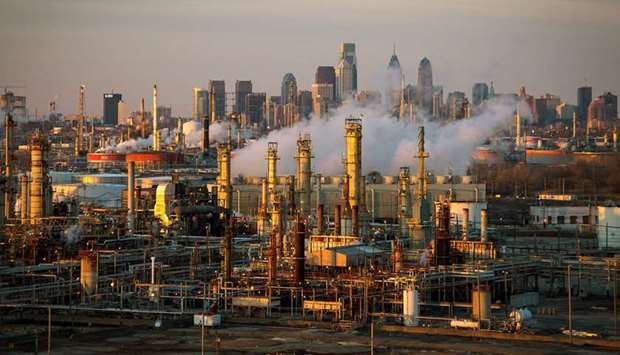A massive fire at Philadelphia Energy Solutions Incorporated (PES)’s oil refinery yesterday damaged the largest US East Coast plant to the point that it could remain shut for an extended period, according to Philadelphia city officials and company sources.
Philadelphia fire officials said several explosions sent a huge fireball into the sky, engulfing the surrounding areas in smoke after 4am EDT (0800 GMT), following the ignition of a fire that started in a butane vat at the 335,000 barrel-per-day (bpd) refining complex, also the oldest in the Northeast.
By mid-afternoon, the city’s fire department was working with the PES in its response to the fire, though it was letting the flammable gases burn under control.
The PES said in a statement it believed the product that was burning was “mostly propane”.
Four workers were injured, according to a company statement, and treated on-site, while city emergency workers treated one person, who did not need to go to the hospital.
The extent of the damage was unknown, but similar fires have shut refineries for months or years.
“It was the worst I’ve ever experienced,” said a veteran refinery worker who was at the plant when the fire broke out. “It looked like a nuclear bomb went off. I thought we were all going to die.”
The complex was still running at a reduced rate, the PES said, but depending on the extent of the damage, there will be questions as to whether the company has enough money to rebuild.
Yesterday’s incident comes just after a June 10 fire at the same refinery, which according to a source familiar with operations, affected a 50,000 bpd catalytic cracking unit..
The PES said in its statement that there were three explosions at the refinery, which affected an alkylation unit.
A source familiar with plant operations said one explosion occurred at a 30,000 bpd alkylation unit that uses hydrofluoric acid, one of the deadliest chemicals in the refining business and a source of controversy for its use to make high-octane gasoline at plants in densely populated areas.
City health officials said there is no immediate danger to the surrounding community.
Preliminary testing at the refinery and the adjacent community showed no ambient carbon monoxide, hydrocarbons (combustibles), or hydrogen sulphide, said Philadelphia Department of Public Health spokesman James Garrow in a statement.
In the past, refinery workers have called for refineries to stop using hydrofluoric acid because of the harm it can do to the eyes, skin and lungs when released into the atmosphere following explosions.
The US Chemical Safety Board, a non-regulatory federal agency that investigates such incidents, is sending a four-person team to look into the explosion.
It has in the past advocated refineries stop using hydrofluoric acid in refining processes.
An explosion at a Los Angeles-area refinery in 2015 kept that plant mostly shut for several years.
In April 2018, a refinery fire and subsequent explosions in Superior, Wisconsin, threatened the release of hydrofluoric acid.
That refinery is still shut and not expected to resume normal operations until 2021.
About 300,000 people live within three miles (5km) of the Philadelphia refinery, according to a 2018 study by California’s South Coast Air Quality Management District, an air quality agency that oversees the Los Angeles area.
That makes it the most densely populated area near a refinery that uses HF alkylation.
The incident comes after years of financial struggles for the refinery, which has slashed worker benefits and scaled back capital projects to save cash.
It went through a bankruptcy process last year to reduce its debt.
The company emerged from bankruptcy in 2018 with $148mn in cash, only to see that fall to $87.7mn just three months later.
Analysts said gasoline supply in the Northeast could be affected by the outage.
Gasoline futures rose 4% yesterday on the news.
The region is likely to boost fuel imports from Europe that are “likely to result in a short-term spike” in already-high gasoline prices, analysts at FGE Energy said in a note.

This file picture shows the Philadelphia Energy Solutions oil refinery at sunset in front of the Philadelphia skyline.


